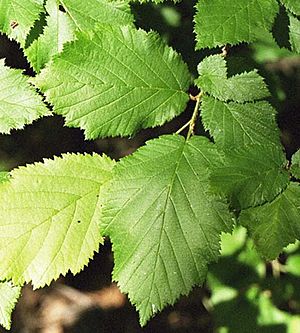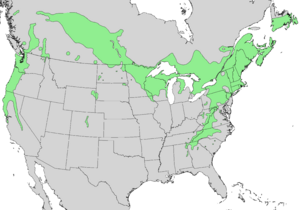Beaked hazelnut facts for kids
Quick facts for kids Beaked hazelnut |
|
|---|---|
 |
|
| Beaked hazel foliage | |
| Conservation status | |
| Scientific classification | |
| Genus: |
Corylus
|
| Species: |
cornuta
|
 |
|
| Natural range of Corylus cornuta | |
| Synonyms | |
|
List
|
|
| Nutritional value per 100 g (3.5 oz) | |
|---|---|
| Energy | 2,629 kJ (628 kcal) |
|
22.98 g
|
|
| Dietary fiber | 9.8 g |
|
52.99 g
|
|
|
Protein
|
14.89 g
|
| Vitamins | Quantity
%DV†
|
| Thiamine (B1) |
42%
0.480 mg |
| Riboflavin (B2) |
13%
0.160 mg |
| Niacin (B3) |
20%
3.190 mg |
| Vitamin B6 |
42%
0.550 mg |
| Minerals | Quantity
%DV†
|
| Calcium |
44%
441 mg |
| Copper |
60%
1.200 mg |
| Iron |
24%
3.12 mg |
| Magnesium |
66%
235 mg |
| Manganese |
362%
7.600 mg |
| Phosphorus |
59%
411 mg |
| Potassium |
25%
738 mg |
| Sodium |
0%
2 mg |
| Zinc |
22%
2.06 mg |
| Other constituents | Quantity |
| Water | 5.92 g |
|
Link to USDA Database entry
|
|
| †Percentages estimated using US recommendations for adults. | |
The Corylus cornuta, also known as the beaked hazelnut, is a type of hazel plant. It is a deciduous shrub, meaning it loses its leaves in the fall. You can find two main kinds of beaked hazelnut across most of North America.
Contents
What is the Beaked Hazelnut?
How Does It Look?
The beaked hazelnut plant can grow quite tall. It usually reaches between 4 to 8 meters (about 13 to 26 feet) high. Its stems can be 10 to 25 centimeters (4 to 10 inches) thick. The bark is smooth and gray.
This plant often grows with several main stems. It can stay smaller if it grows in the shade of other plants.
Leaves and Flowers
The leaves are green and shaped like a rounded oval. They have a pointed tip and are double-toothed along the edges. Each leaf is about 5 to 11 cm (2 to 4.5 inches) long and 3 to 8 cm (1 to 3 inches) wide. The underside of the leaves feels soft and hairy.
Male flowers look like long, hanging structures called catkins. They form in the autumn. The tiny female flowers appear in the spring. After pollination, the fruits grow through the summer.
The "Beak" and Nuts
The beaked hazelnut gets its name from its fruit. The fruit is a nut that sits inside a husk. This husk has a tube-like part that is 2 to 4 cm (about 1 to 1.5 inches) long. This part looks just like a bird's beak!
Small, prickly hairs stick out from the husk. These hairs can irritate your skin if you touch them. The nuts inside are small and round. They have a very hard shell.
Tough Plant Roots
This hazelnut is one of the toughest hazel species. It can survive very cold temperatures, even as low as -50 degrees Celsius (-58 degrees Fahrenheit).
It has roots that are not very deep, usually only about 15 cm (6 inches) down. However, these roots are very dense. It also has one main taproot that can go deeper, up to 0.6 meters (2 feet) into the ground.
Different Kinds of Beaked Hazelnut
There are two main types, or varieties, of beaked hazelnut. They grow in different parts of North America.
- Corylus cornuta var. cornuta – This is the Eastern beaked hazel. It is a smaller shrub, growing 4 to 6 meters (13 to 20 feet) tall. Its "beak" is longer, usually 3 cm (1.2 inches) or more. You can find it at elevations from 100 to 500 meters (330 to 1,640 feet) across its range. In Alberta, it can grow up to 1,000 meters (3,300 feet) high.
- Corylus cornuta var. californica – This is the Western beaked hazel or California hazelnut. It is a larger shrub, growing 4 to 15 meters (13 to 49 feet) tall. Its "beak" is shorter, usually less than 3 cm (1.2 inches). It grows below 2,100 meters (6,900 feet) in California. In British Columbia, it grows below 800 meters (2,600 feet). The Concow tribe called this variety gōm’-he’’-ni.
Where Does It Grow?
The Eastern beaked hazelnut grows from southern Canada all the way south to Georgia. The Western beaked hazelnut grows along the west coast. You can find it from Alaska down to California.
How Does It Fit in Nature?
The beaked hazelnut can handle some shade. However, it grows better in forests where the tree tops are fairly open. It does not like completely open areas that get very hot and dry.
If there is a fire, the part of the shrub above ground might die. But the plant can grow back easily from its roots. Native Americans in California and Oregon even used fire to help this plant grow more.
In northern forest areas, a plant called the Siberian peashrub can be a problem. It can take over areas where beaked hazelnut grows.
Animals and the Beaked Hazelnut
Many animals use the beaked hazelnut.
Food for Animals
- Deer, moose, and farm animals eat the leaves of the Eastern beaked hazel.
- The Western beaked hazel is not a favorite food for large grazing animals.
- The hazelnut weevil only eats the Western beaked hazel.
- American beavers really like to eat Eastern beaked hazel. They eat so much that it helps other trees, like conifers, grow more.
The nuts of the California hazelnut are an important food for squirrels. They are especially helpful when other foods, like acorns, are scarce. Squirrels like Douglas squirrels, red squirrels, and least chipmunks collect and hide the nuts. Even though they eat most of them, the buried nuts have a better chance of growing into new plants.
Birds like jays also help spread the nuts. Blue jays in the east and Steller's jays in the west carry them farther than squirrels do. Black bears, turkeys, and white-tailed deer also enjoy eating the nuts.
Ruffed grouse birds eat the protein-rich catkins and young buds of the beaked hazelnut.
Shelter for Animals
Many animal species use the beaked hazelnut for cover. It is a good place for birds to build nests, especially the ruffed grouse. The white-footed vole (a small rodent) is often found where California hazelnuts grow in the Umpqua National Forest in Oregon.
How Do People Use It?
Native Americans used the young shoots of the beaked hazelnut. They made baskets, fish traps, and baby carriers from them. The nuts were eaten and traded among different groups. Explorers like the Lewis and Clark expedition and the naturalist David Douglas traded for beaked hazelnuts with local people.
The plant was also used as medicine. It was used to help with teething, as a way to make people vomit, to get rid of worms, and to tighten body tissues.
The nuts are considered excellent to eat, just like other hazelnuts. The beaked hazelnut does not produce as many nuts as commercial types like the common hazel. However, it is much better at resisting common plant diseases. Because of this, it has been used in breeding programs. These programs aim to create new hazelnut plants that produce many nuts and are also disease-resistant.
The beaked hazelnut is also used in restoration projects. These projects plant it to increase the variety of plants and animals in an area. It also helps provide more food for wildlife. Additionally, it can help reduce a root disease in nearby Douglas-fir and Sitka spruce trees.
Gallery
See also
 In Spanish: Corylus cornuta para niños
In Spanish: Corylus cornuta para niños







